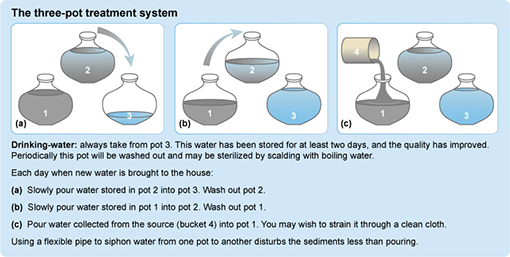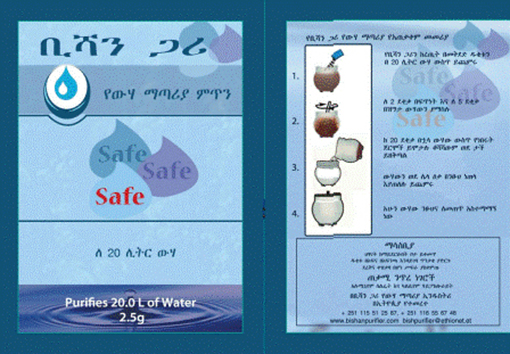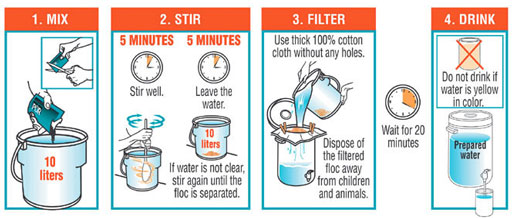Use 'Print preview' to check the number of pages and printer settings.
Print functionality varies between browsers.
Printable page generated Tuesday, 23 April 2024, 2:34 PM
Study Session 10 Household Water Collection, Treatment, Storage and Handling
Introduction
Water utilities are responsible for putting fully treated water into the distribution system, but it can become contaminated after it has left the treatment works if not handled with care. The contamination can originate from several different sources, but it is obviously important to eliminate any introduction of faecal material for health reasons. Research in Sodo woreda, Guraghe Zone, in the Southern Nations, Nationalities and Peoples’ Region (SNNPR) showed that 61% of the water in households was faecally contaminated and for five woredas in Amhara Region the figure was 74% (Kinfegabriel, 2015). These findings demonstrate that safe water collection, treatment and handling at household level are key considerations for potable water availability in the home.
This study session will discuss safe water collection methods and the ways in which water can be treated at household level. It also presents the basic principles of safe water storage and handling in the home.
Learning Outcomes for Study Session 10
When you have studied this session, you should be able to:
10.1 Define and use correctly the key words printed in bold. (SAQ 10.1)
10.2 List the methods by which households can safely collect water for use. (SAQ 10.2)
10.3 Describe the methods by which water can be treated at household level. (SAQ 10.1)
10.4 Describe the options for safe storage of water. (SAQ 10.3)
10.5 Summarise the methods for safe handling of water in the home. (SAQ 10.3)
10.1 Methods of safe household water collection
Households in urban areas that do not have a tap connection in their house or yard will probably collect water from a water point or kiosk. Even where there is a household connection, residents may sometimes need to use other sources, for example if there is a break in supply. In longer-term emergency situations, safe water may be delivered by tanker to residential areas for distribution to householders. In both of these instances, collection vessels such as those shown in Figure 10.1 will be used to carry water to the home.
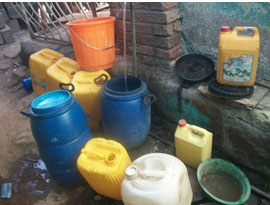
A water container has to be clean, and must not previously have been used to contain any toxic material (such as pesticides). Ideally, the mouth of the vessel should be narrow and it should have a lid. It should have handles so that it can be carried easily.
Why is it better to have a container with a narrow opening?
This reduces the chances of contamination because less of the water is exposed. Most importantly, people will not be able to put their hands into the water, which is one of the most likely sources of contamination.
An alternative to the containers shown in Figure 10.1 is the Hippo Water Roller (Figure 10.2), which enables water to be transported more easily and efficiently. It is a 90-litre drum made from UV-stabilised, low-density polyethylene that can be rolled along the ground using a steel clip-on handle. The device is designed to cope with rough surfaces and is very stable in the upright position. The roller is rounded at the shoulders and has hand grips at the top and bottom to make it easier to tilt a full roller when pouring.
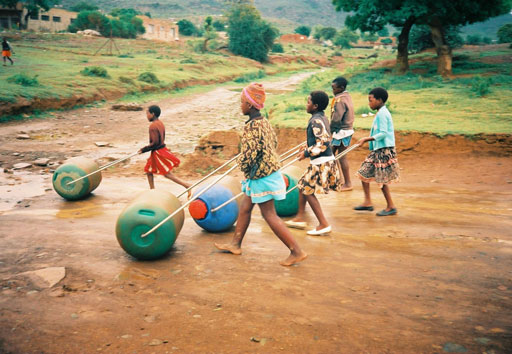
10.2 Methods of household treatment of water
What is sedimentation?
Sedimentation is the removal of suspended solids through the settling of particles.
Just as in the water treatment works, if the water is turbid (muddy), then giving it time to settle (become calm) helps in sedimentation. This process can be assisted by adding a coagulant that encourages the formation of larger, heavier particles (flocculation) that then settle easily to the bottom of the container and make the water clear. At the household level, natural coagulants can be used such as the crushed, dry seeds of the Moringa fruit, shown in Figure 10.3 (Davis and Lambert, 1995). Moringa fruit comes from Moringa trees, which grow in tropical countries
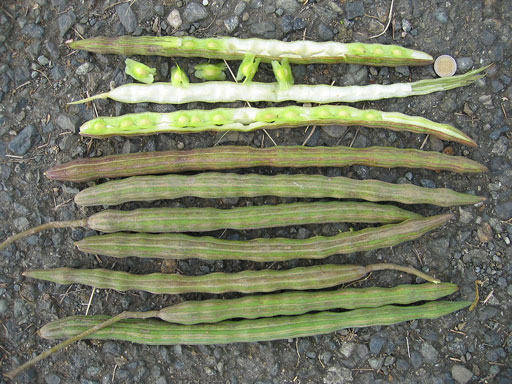
Can you name one of the coagulants used in large-scale water treatment?
As you learned in Study Session 5, Section 5.2.3, aluminium sulphate and ferric chloride are used as coagulants in large-scale water treatment.
After the suspended particles have settled, the clear water at the top can be carefully poured into another container for further processing. The three-pot method is one method of sedimentation.
The three-pot method
The three-pot method (Figure 10.4) is a means of reducing dirt and micro-organisms in water, by storing the water in a container, allowing the dirt to settle, and moving the cleaner water to different containers over time. Water in a container should be allowed to settle for a day before it is decanted into the next container. Only water from Pot 3 should be consumed. The three-pot system is low-cost, easy to use and is something people can do themselves. However, it does not totally remove disease-causing micro-organisms, so some method of disinfection is still needed to remove the risk of disease completely.
10.2.2 Filtration
Filtration is another method of removing suspended particles and is also relatively easy. There are several different methods of filtration that can be used in the home.
Cloth filtration
Cloth filtration (Figure 10.5) is cheap, easy to carry out and a common water treatment technique. Pouring turbid water through a piece of fine, clean cotton cloth will remove larger contaminants and a certain amount of suspended solids. It is better to use a used, rather than new, piece of cloth.
Why do you think a used, washed piece of cloth is better for filtration?
Once cloth has been washed several times, the gaps between the fibres it is made from are smaller and therefore better for trapping any solid matter.
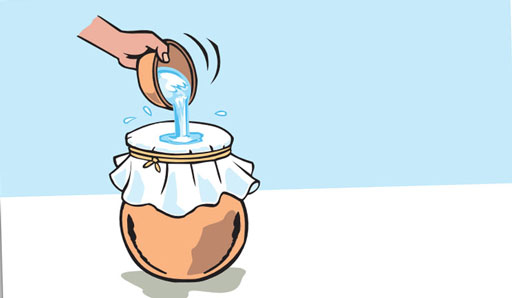
The steps in cloth filtration are as follows:
- Use a large cloth, preferably made of finely-woven cotton. Fold the cloth at least four times so that there are multiple layers of fabric, and place this over the opening of the storage vessel.
- The cloth, once folded, must be big enough to easily cover the opening of the receiving water container.
- Place the cloth over the mouth of the container.
- Fasten the cloth securely around the rim of the opening, using string. If reusing the cloth, always use the same side up each time.
- Pour the water through the cloth, into the container.
- Wash the filter cloth after each use, with a final rinse using cloth-filtered water, and then leave the cloth in the sun until it is dry.
- Clean the cloth regularly using detergent, and use a new piece of cloth as soon as there are any visible tears or holes.
- Always keep filtered water separate from non-filtered water.
Household sand filtration
A household sand filter can usually be made from locally available and inexpensive materials like clay pots or barrels. They are simple and easy to use. One such system consists of a pot and a storage vessel (Figure 10.6).
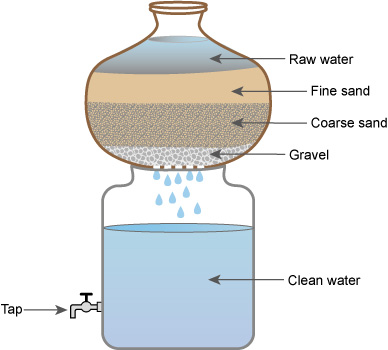
The details of the system are as follows:
- The bottom of the pot is perforated (has tiny holes in it).
- The pot contains layers of gravel (about 5 cm deep), coarse sand (about 5 cm deep) and fine sand (about 10 cm deep).
- Water is poured in at the top and, as it passes through the layers, any particles within it are filtered out.
- Clean water drips into the storage container.
- The storage container should have a tap to enable the clean water to be drawn out easily and safely.
- The sand and gravel should be changed when the rate of filtration starts to slow; at a minimum it should be changed every two to three months.
Ceramic filtration
For ceramic filtration, a water filter in the form of a ceramic pot can be made using clay, sawdust or rice husks, and a plastic bucket. The pot is made by mixing clay with the sawdust or rice husks, forming it into a flowerpot shape and then firing it in a kiln. The sawdust or rice husks burn away, leaving tiny pores in the ceramic through which water can be filtered. The small pore size of the ceramic material traps the particles and most micro-organisms.
To use the filter, the pot is inserted into a container so that its lip prevents it from slipping into the container (Figure 10.7). The raw water is then poured into the ceramic pot. Cleaned water percolates out of the pot and is collected in the container below. A tap on the container allows water to be drawn out.
The filter is cleaned by gently scrubbing the surface, and it is recommended that the filter be replaced every 1–2 years, as fine cracks not visible to the naked eye may have developed.
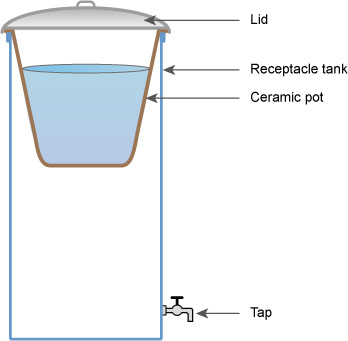
10.2.3 Disinfection
Disinfection is the final stage of water treatment in the home. All water treated using one or more of the previous steps will need to be disinfected to ensure that all pathogens are killed. The three common methods of disinfection are described below.
Boiling
Boiling drinking water is a simple way of killing pathogens and is suitable for use at household level. Boiling destroys pathogens such as bacteria and viruses, and any parasite ova (eggs) present in water. The water should be heated until large bubbles come continuously to the surface of the water (referred to as a ‘rolling boil’), for at least 5 minutes. This has been shown to inactivate cholera and Shigella organisms (Luff and Clarke, 2006). If the location of the site is at a high elevation (as in Addis Ababa) the water should be boiled for longer. Boiling will make the water taste flat but this can be remedied by shaking the water in a clean bottle, or by adding a pinch of salt to one litre of water. If the water is turbid with particles, it should be filtered before boiling. Water should be boiled, cooled and stored, all in the one container and consumed within 24 hours to prevent re-contamination.
Can you think of disadvantages associated with boiling?
Fuel has to be obtained, and scalding accidents can occur if people are careless. But it is still the simplest way of ensuring that water is safe to drink.
Solar disinfection (SODIS)
Solar disinfection, known as SODIS, is a water treatment method that uses ultraviolet (UV) radiation and high temperature from the sun to destroy micro-organisms in water. The technique requires only some clear plastic bottles (without labels) and sunlight (Figure 10.8).

The steps to take for SODIS are shown in Figure 10.9. In Step 5, the bottles are placed on a corrugated iron sheet (often used as roofing material) which is painted black so that it retains heat from the sun, speeding up the rate of heating of the water.
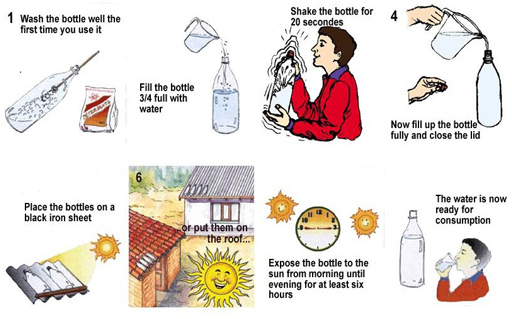
Chemical disinfection using chlorine
Chlorine solution, also known as sodium hypochlorite or bleach, is the most affordable and widely available chemical for household water treatment. Typically the procedure is to add a capful of chlorine solution to water in a 20–25 litre storage container, then stir and wait for 30 minutes. As you learned in Study Session 5, this period of time is referred to as the contact time. After this, the water can be used.
Chlorination is effective if the water is not turbid. If the water is turbid, micro-organisms can shelter within the particles and escape the effect of the chlorine. Solids should therefore first be removed by sedimentation or filtration. It is important that some residual chlorine remains in the water at the time it is used, so that it stays safe to drink. A minimum concentration of 0.5 mg l–1 is recommended; this will kill any organism that enters the water later.
10.3 Household water treatment using commercial products
One example you may be familiar with is Wuha Agar, a commercial product available in Ethiopia for household water treatment. It is a chlorine-based solution used for disinfection, as described above. There are several others.
10.3.1 Bishan Gari Water Purifier
The Bishan Gari Water Purifier (Figure 10.10) is a combined coagulant–flocculant–disinfectant powder mixture produced in Ethiopia for water treatment. Bishan Gari comes in a 2.5-g sachet, which is used to treat 20 litres of water. The sachet contains aluminium sulphate as coagulant and a flocculant for reducing turbidity, and calcium hypochlorite as a disinfectant to kill bacteria and viruses.
The directions for using Bishan Gari powder are as follows:
- Put 20 litres of raw water into a clean bucket.
- Open the Bishan Gari sachet and add the contents to the bucket.
- Stir rapidly with a stick for 2 minutes (to disperse the chemicals) and then stir slowly for an additional 3–4 minutes (to help the solid particles come together to form larger particles or flocs).
- Wait for at least 20 minutes for the flocs to settle and the micro-organism to die. The longer you wait, the clearer the treated water will be.
- Strain the water through a thick cotton cloth into a safe water storage container, from which it can be consumed.
- Dispose of the material that settles at the bottom of the bucket by burying it.
10.3.2 Aquatabs
Aquatabs is the brand name of a solid form of sodium dichloroisocyanurate (NaDCC), a disinfectant. The tablets (Figure 10.11), which have to be imported, are easier than bleach to store, handle and transport. One tablet contains 67 mg of NaDCC and can treat 20 litres of clear water. The tablet has to be dissolved in the water by vigorous mixing, and a contact time of 30 minutes is necessary. If the water is turbid, two tablets will be needed.
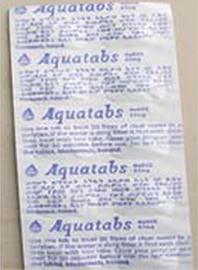
10.3.3 P&G Purifier of water
P&G Purifier of Water is the brand name of a combined coagulant, flocculant and disinfectant product produced by Procter & Gamble (Figure 10.12), which is imported into Ethiopia. The coagulant/flocculant is ferrous sulphate and the disinfectant is calcium hypochlorite. It can be used to treat raw source waters with a wide range of turbidity and pathogen load. This water treatment chemical allows flocculation to take place and helps to remove Giardia and Cryptosporidium cysts that are resistant to chlorine disinfection. (A cyst is a dormant stage in the life cycle of some protozoa and bacteria that is resistant to adverse environmental conditions and therefore difficult to destroy.) P&G Purifier of Water comes in sachets and one sachet is needed to treat 10 litres of water.
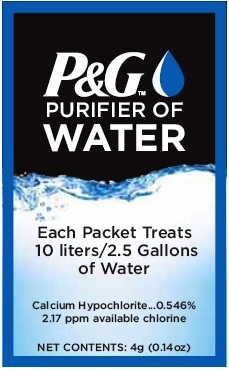
The procedure for using P&G Purifier of Water is illustrated in Figure 10.13.
10.4 Safe storage and handling of water in the home
The most desirable specification for a water storage vessel for households is that it:
- has a capacity of between 10 and 25 litres, is rectangular or cylindrical with a flat base and has one or more handles, for portability, stability and ease of storage
- is made oflightweight, oxidation-resistant plastic (so that it does not deteriorate with time), such as high-density polyethylene or polypropylene, for durability and shock resistance
- is opaque to prevent the growth of algae
- is fitted with a screw-cap opening that is wide enough to facilitate cleaning but small enough to discourage or prevent the introduction of hands or dipping utensils
- is fitted with a durable tap for dispensing water so that human contact with the stored water is impossible (Figure 10.14).
Why is the recommended upper limit for the water storage vessel 25 litres?
The weight of 25 litres of water is 25 kg. This is just about manageable for an adult to lift.
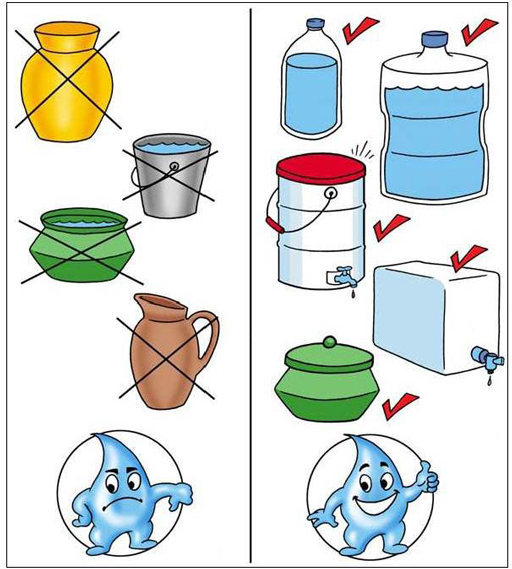
Having collected, transported, treated and stored the water, households have to handle the water carefully so that it does not become contaminated. It is essential that hands are not put into the treated water. The best option is to use a tap. If the container does not have a tap, and the container has a narrow neck, the water can be poured out carefully. If the container has a wide neck, a long-handled ladle (Figure 10.15) should be used to take the water out of the container. This is preferable to using a mug or jug, because hands can inadvertently contaminate the water.
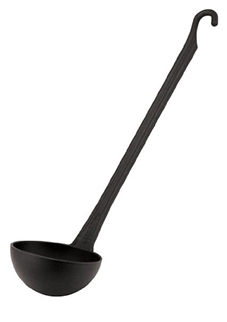
Summary of Study Session 10
In Study Session 10 you have learned that:
- Households may have to collect their own water if there is no water distribution system to take water to individual houses. They may also have to do this if there is a water emergency and water is distributed by tankers.
- A container used to collect the water must be clean and must not have previously held any toxic compounds. It should have a narrow mouth, a lid, and handles for portability. An easy option is to use the Hippo Water Roller.
- Household water treatment is needed if the safety of the water for human consumption is in any doubt.
- Removal of suspended particles is the first step in household water treatment. This can be done by sedimentation, for example by using the three-pot method.
- The crushed seeds of the Moringa fruit can be used as a natural coagulant, to aid sedimentation of solids.
- Filtration (for example, by using cloth, a household sand filter, or a ceramic filter) is also a way to remove suspended particles.
- Disinfection (for example, by boiling or using solar energy) eliminates pathogenic (disease-causing) micro-organisms from the water.
- Water treatment chemicals such as Wuha Agar, Bishan Gari, Aquatabs and P&G Purifier of Water can also be used for household water treatment.
- The ideal household storage container for treated water is made of lightweight, oxidation-resistant, opaque plastic, with a screw-cap opening for ease of cleaning, handles for portability and a tap to eliminate human contact with the water inside the container. When handling treated water, a tap or a long-handled ladle should be used.
Self-Assessment Questions for Study Session 10
Now that you have completed this study session, you can assess how well you have achieved its Learning Outcomes by answering these questions.
SAQ 10.1 (tests Learning Outcomes 10.1 and 10.3)
This SAQ is based on key words you have come across in earlier study sessions as well as this one.
Kedir Seid, a Senior Environmental Health Officer, has been informed that there has been an emergency regarding the water supply in his town. The main pipeline has been breached by an excavator at a construction site and mud has been drawn into the water supply. The muddy water is now reaching 2000 homes. Kedir puts together a leaflet to tell people what to do with the muddy water to make it safe to use. Help him in this task by inserting the correct words (from the selection given below) into the gaps in his message:
a cloth, Bishan Gari, boiling the water, ceramic filtration, clear plastic bottles, coagulants, contact time, disinfected, filtration, five, household sand filter, Moringa fruit, pathogenic, sedimentation, settle out the mud, six, solar disinfection, three-pot method, two, Wuha Agar.
Dear Householders,
The water supply is presently muddy due to an accidental breakage of the main water line. Do not worry. We have ways of making the water safe. The first thing to do is to ……………… This can be done by a process called ……………… To encourage this, we can use ……………… The crushed seeds of the ……………… can be used as a natural coagulant. If many containers are available in your household, the ……………… is an option. In this method, the water is settled for at least ……………… days before consumption. Another way to get rid of the mud is by ……………… The simplest way is to use ……………… If you have time, you can make your own ……………… using a pot and a container, sand and gravel. A third option is to use ……………… but this involves setting up a new system that is more costly than the two mentioned just now.
Now, after sedimentation or filtration the water will look clean – but it probably isn’t, because of micro-organisms that may be present. To get rid of any ……………… micro-organisms, the water has to be ……………… Perhaps the easiest, most effective and fastest way of doing this is by ……………… In a city like Addis Ababa, which is at high altitude, we need to boil the water for ……………… minutes. If we do not have fuel at hand, or want to save fuel, we can use ……………… For this we need to put the water into ………………, with their labels removed, and expose it to sunlight for ……………… hours. Another way is to use Aquatabs, which require a ……………… of 30 minutes.
We will do our best to repair the pipe as soon as possible but if we can’t, we will deliver water treatment chemicals like ……………… and sachets of ……………… to you. With these we will send technicians to give guidance on how they are to be used.
With best wishes,
Yours sincerely,
Kedir Seid
(Senior Environmental Health Officer)
Answer
Here is Kedir’s completed message.
Dear Householders,
The water supply is presently muddy due to an accidental breakage of the main water line. Do not worry. We have ways of making the water safe. The first thing to do is to settle out the mud. This can be done by a process called sedimentation. To encourage this, we can use coagulants. The crushed seeds of the Moringa fruit can be used as a natural coagulant. If many containers are available in your household, the three-pot method is an option. In this method, the water is settled for at least twodays before consumption. Another way to get rid of the mud is by filtration. The simplest way is to use a cloth. If you have time, you can make your own household sand filter using a pot and a container, sand and gravel. A third option is to use ceramic filtration but this involves setting up a new system that is more costly than the two mentioned just now.
Now, after sedimentation or filtration the water will look clean – but it probably isn’t, because of micro-organisms that may be present. To get rid of any pathogenic micro-organisms, the water has to be disinfected. Perhaps the easiest, most effective and fastest way of doing this is by boiling the water for five minutes. If we do not have fuel at hand, or want to save fuel, we can use solar disinfection. For this we need to put the water into clear plastic bottles, with their labels removed, and expose it to sunlight for six hours. Another way is to use Aquatabs, which require a contact time of 30 minutes.
We will do our best to repair the pipe as soon as possible but if we can’t, we will deliver water treatment chemicals like Wuha Agar and sachets of Bishan Gari to you. With these we will send technicians to give guidance on how they are to be used.
With best wishes,
Yours sincerely,
Kedir Seid
(Senior Environmental Health Officer)
SAQ 10.2 (tests Learning Outcome 10.2)
An emergency has occurred with the water supply and a tanker is coming to your area to distribute water to the residents. If you were an Environmental Health Officer, what advice would you give the residents as to the best type of container to use to collect the water?
Answer
The water collection container should be clean, have handles and not have contained anything toxic before. The mouth of the container should be narrow and have a lid.
SAQ 10.3 (tests Learning Outcomes 10.4 and 10.5)
Which of the following statements are false? In each case, explain your answer.
- A.Any opaque plastic container will be satisfactory for storing water at home because, unlike metal, it will not rust.
- B.It is best to have a container that holds a maximum of 25 litres, as that can be easily carried.
- C.The water storage container should have a very narrow opening so that no contaminants can get in.
- D.A tap is an ideal way of keeping stored water safe from contamination.
- E.If the water is stored in a wide-necked container without a tap, and a long-handled ladle is not available, a mug can be used to take the water out.
Answer
A is false. The plastic should be resistant to oxidation so that it lasts a long time.
C is false. The opening should be 6–9 cm wide to facilitate cleaning of the container.
E is false. This method of taking the water out is likely to lead to the transfer of contamination from hands to the water within the container.
